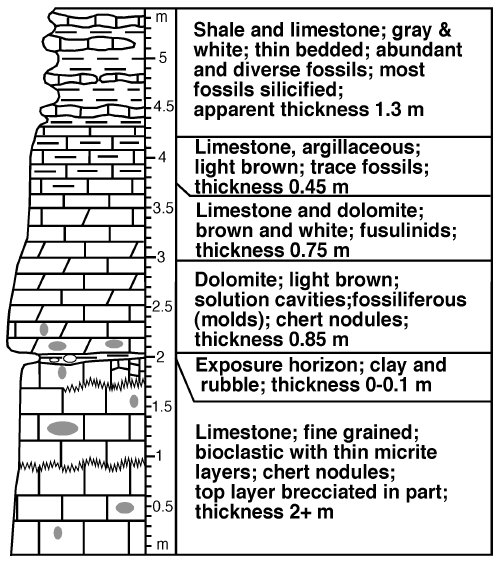
Stratigraphy
Gzhelian Stage, Rusavkian substage
Gzhel quarry, Gzhel village
Click on chart to magnify
The Gzhel quarry site south of the Gzhel train station is a well
known site for Gzhelian fossils (Ivanova & Khvorova, 1955) and is the
location where the Gzhelian stage was first defined (Nikitin, 1890).
Recent study (Alekseev et al., 2004; Heckel, Alekseev et al., 2005)
places the Kasimovian-Gzhelian boundary at the level of a prominent
exposure horizon in the middle of the section, separating Kasimovian
age strata below from early Gzhelian (Rusavkian) strata above. This
new determination of the base of the Gzhelian is based on the lowest
appearance of the conodont Idiognathodus similator (Ellison, 1941),
the fossil now used to define the Kasimovian-Gzhelian boundary.The exposure horizon was produced during a major drop in sealevel
that exposed the Kasimovian sediments. The following Early Gzhelian
marine transgression deposited sediments during a time of rising
sealevel. These transgressive deposits are part of the upper
Rusavkino cyclothem, a unit that correlates to the Oread cyclothem
(with Heebner Shale) of the midcontinent in North America and its
equivalent Finis cycle of Texas. The base of the upper Rusavkino
cycle defines the base of the global Gzhelian stage, which is close
to the base of the traditional North American Virgilian stage.Click on Pictures to magnify
1
Gzhel quarry section before excavation
3
Gzhel quarry section: white limestone below and transgressive
brown dolomite above exposure horizon (exposure horizon
forms a recess, separating white and brown strata).
4
Interbeds of limestone and shale at top of section
5
Fossiliferous limestone at top of section
6
Thin bedded limestone near top of section
7
Resistant ledge of argillaceous coarse dolomite in middle of section,
showing vugs created by dissolution. White cavity at base of photo
is secondarily filled with white mineral. Basal unit of transgression.
8
Closeup of exposure horizon with paleosol (fossil soil) on top of
white limestone unit and below resistant dolostone unit. Note the
broken rubble zone on top of while limestone and the solution
cavities formed by dissolution of fossils and clasts in the dolostone.
9
Blocky white limestone at base of section
References:
Alekseev, A.S., Goreva, N.V., Isokova, T.N. and Makhina, M.K., 2004,
Biostratigraphy of the Carboniferous in the Moscow Syneclise [basin],
Russia; Newsletter on Carboniferous Stratigraphy, v. 22, p. 28-35.Heckel, P.H., Alekseev, A.S. and 12 others, 2005, Cyclothem
(sequence-stratigraphic) correlation and biostratigraphy across the
Moscovian-Kasimovian and Kasimovian-Gzhelian stage boundaries (upper
Pennsylvanian Series) in North America and Eurasia; Newsletter on
Carboniferous Stratigraphy, v. 23, p. 36-40.Ivanova, E.A. and Khvorova, I.V., 1955, Stratigraphy of the Middle
and Upper Carboniferous in the western Moskovskaya Syneclise; Academy
of Sciences of the USSR, Proceedings of the Paleontological Institute
(Trudy), Moscow, v. 53, Book 1, p. 209-210.Nikitin, S.N., 1890, Depot carbonifere et puits artesian dans le
region de Moscou; Memoires Comite de Geologie, tome 5, no. 5Top of Page
Site Search Engine
search Carboniferous fossils of Russia or the Web
Site Links
Stratigraphy and Sediments
Gzhel quarry, Gzhel village
Pennsylvanian
Gzhel quarry, Gzhel village
Mississippian
Visean Stage, Aleksian-Mikhailovian substages
Home Page
Carboniferous fossils of Russia
The Pictures on this web site are the sole
and personal property of Dr. Alexander Davydov
and Barry Sutton. Unauthorized use of any
picture(s) on this web site is Strictly Prohibited.
© All rights reservedContact:
Barry Sutton and Alexander Davydov
Russia@LakeNeosho.org